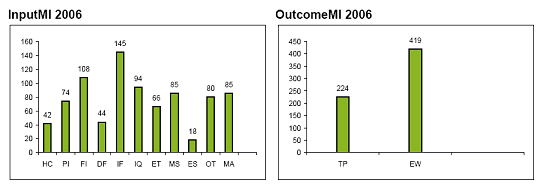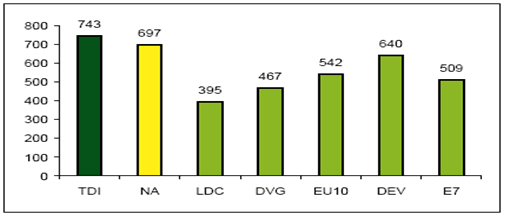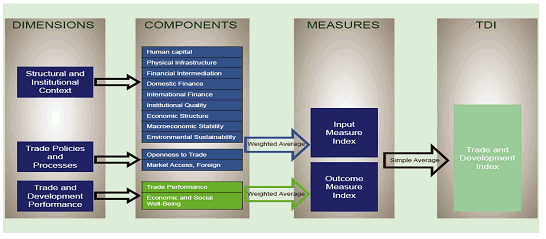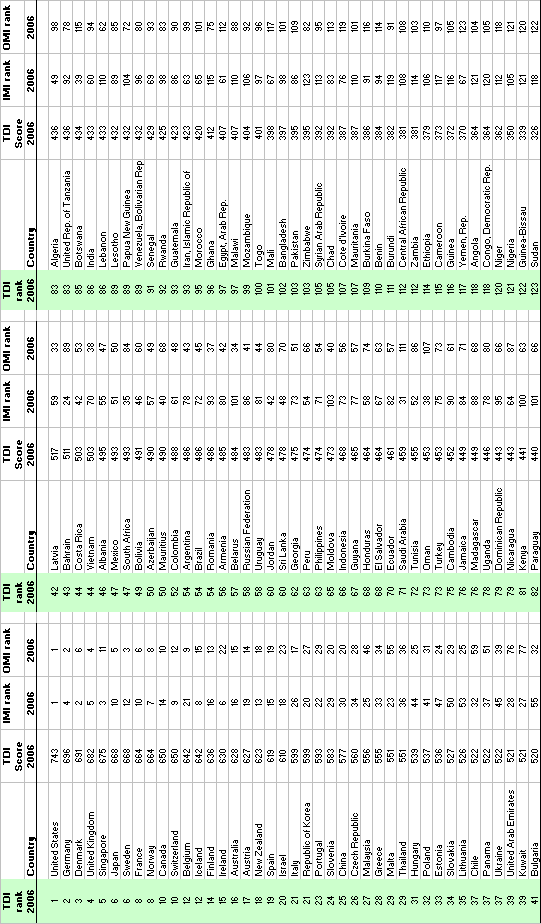| EMBARGO The contents of this press release and the related Report must not be quoted or summarized in the print, broadcast or electronic media before 6 November 2007, 17:00 GMT |
Leaders, improvers and laggards in trade and development performance - results of UNCTAD new edition of Trade and Development Index
WASHINGTON, November 6, 2007: The United States again had the world´s best combination last year of economic, social, regulatory, and government attributes for engaging in and benefiting from global trade and for using the benefits to raise living standards, according to a United Nations Conference on Trade and Development (UNCTAD) study released today. The US "score" on the UNCTAD Trade and Development Index relates to data from the year 2006, so it does not incorporate the effects of the recent economic and social difficulties associated with macroeconomic imbalances, the weakening dollar, and the housing market crunch.
The Index is reviewed and explained in detail in the UNCTAD publication Developing Countries in International Trade 2007- Trade and Development Index, (1) released today. The TDI is a comprehensive review of global trade and development performance, integrating almost all key factors and indicators affecting trade and development in all countries, whether developing or developed. It was conceived to provide an innovative analytical and benchmarking tool to assess trade policies in interaction with development strategies at the national level in order to promote balanced economic and social development in developing countries, least developed countries, and countries with economies in transition.
The United States´ performance
The high scores obtained by the US in 2006 for its trade performance (i.e. ability to engage in trade), and economic and social well-being (health and general living standards) largely explain why it has taken the lead in this year´s TDI.
US scores on human capital (education and skills affecting the economy), economic structure, international finance, and quality of institutions (i.e. the functioning of government agencies) are similar to those of other developed countries. However, it achieved substantially higher scores for the stability of its macroeconomic policies and physical infrastructure (roads, ports, electricity generation, and information communications technologies) than all other country groupings. The same is also true for financial intermediation (such as services offered by banks), but lags behind in domestic finance (general availability of credit) (see Figure 1).
The TDI shows that most countries, developed or developing, are now relatively comparable in terms of "openness" to trade -- that is, they have largely reduced barriers such as tariffs, laws impeding foreign investment or business development, and red tape that delays or complicates the process of importing and exporting goods. The new results also point to encouraging news: a number of developing nations significantly improved their scores on such factors as domestic finance, economic structure, macroeconomic stability, and environmental sustainability.
Emerging Seven Economies (E7)
The TDI study introduces a new concept of Emerging Seven Economies (E7) - Brazil, India, China, Republic of Korea, Mexico, the Russian Federation, and South Africa. All E7 economies increased their TDI scores between 2005 and 2006, with China achieving the highest increase, followed by India. On average, E7 countries have better TDI scores than other developing countries, and the gap between their scores and those of EU10 countries, which acceded the European Union in 2004, is not large and has rather rapidly narrowed (see Figure 2).
What is TDI?
The new UNCTAD report Developing Countries in International Trade 2007 - Trade and Development Index (TDI) identifies the complex interdependence of current economic conditions in developing countries, developed nations and countries in transition and the strengths and weaknesses of their respective institutional and policy environments. The report provides yardsticks which developing countries and countries in transition can use to analyze their performance against benchmarks set by developed countries.
The TDI also provides perspectives ranging from comparisons between regions to comparisons of individual countries. A new feature of this year´s edition is a series of country profiles for each of the 123 countries represented in the analysis. These profiles present three sets of information: selected indicators; a comparison between the TDI scores obtained in 2005 and 2006 (based on newly refined methodology and data); the degree to which an individual country has climbed up the development ladder; and a comparison of its performance with other countries.
The TDI framework serves three major purposes:
- It is a measure of the degree of integration between trade and economic and social development;
- It is a diagnostic tool that allows policymakers and practitioners to identify possible constraints to using trade as a vehicle for social and economic development;
- It is a benchmarking tool that allows the monitoring of changes in the factors defining the degree of integration between trade and economic and social development, and their sources.
The main purpose of the TDI is to help governments -- especially those struggling with poverty and sluggish development -- to determine what to do to participate more effectively in the global economy and to benefit from world trade to speed up national economic growth, create jobs, and improve general well-being. The TDI shows how effectively international trade is integrated into the development of individual countries.
"Conventional mainstream technical analyses of trade performance often overlook the crucial relation between trade and development," explains Dr. Supachai Panitchpakdi, Secretary-General of UNCTAD. "Analysis through the TDI framework brings country-specific constraints to the forefront by simultaneously identifying the structural, institutional, financial, trade and development policies that allow developing countries to maximize benefits and minimize costs from trade liberalization and globalization."
TDI scores are an average of two basic UNCTAD research processes: one reflects the structural profile of a country, and the other its performance in terms of trade and social and economic development. Each process is a weighted average of indicators economically relevant in the context of the TDI framework.
The new TDI incorporates 11 components and 34 specific indicators.
Concluding remarks
A key result of the TDI 2006 analysis which will help to inform policy decisions at both international and national levels is the discovery through statistical analysis of a general rule that says, "the lower the variability in input components, the higher the output scores". A policy implication of this relationship is that disproportionate emphasis on a limited number of trade and development objectives is likely to yield only marginal results.
"Focusing on trade liberalization alone is unlikely to achieve the desired results" says Mr. Supachai. "Policymakers, especially in developing countries, need also to promote other measures such as macroeconomic and financial management, as well as trade support and industrial policies. Only then will they close the gap with more advanced economies".
The value of the Trade and Development Index is that its findings indicate in a direct and clear manner that developing nations can reap greater trade and development dividends, if they adopt effective and coherent policy frameworks. Too many countries are still focusing too much on a limited number of trade and development objectives. Focusing on trade liberalization alone is unlikely to achieve the desired results.
This year´s TDI also introduces its Advisory Board composed of prominent academics from all regions under the chairmanship of Professor Lawrence R. Klein, 1980 Nobel Laureate in Economic Sciences.
"UNCTAD has laid a solid framework in establishing new standards for examining progress in world economic and social development," explains Professor Klein. "This second release of TDI measures has expanded country coverage, broadened the scope of quantitative analysis, and covers new time periods. This is of extreme importance among, as well as within, countries as it sheds light on the existence of poverty in all too many countries".
Note for Editors
Established in 1964, UNCTAD promotes the development-friendly integration of developing countries into the world economy and international trading system. UNCTAD has progressively evolved into an authoritative knowledge-based institution whose work aims to help shape current policy debates and thinking on development, and generate new idea, with a particular focus on the integrated and coherent treatment of trade, investment and other development-related issues.
ANNEX
Tables and figures
Figure 1: The United States´ performance on TDI components
Note: HC (Human capital), PI (Physical infrastructure), FI (Financial intermediation), DF (Domestic finance), IF (International Finance), IQ (Institutional quality), ET (Economic structure), MS (Macroeconomic stability), ES (Environmental Sustainability), OT (Openness to Trade), MA (Access to foreign market), TP (Trade performance), and EW (Economic and social well-being)
Figure 2: Comparing the United States performance on TDI with other country groupings
Note: The ´bar´ indicates the score of TDI. The first ´bar´ indicates TDI score of the United States. The average TDI are shown for all other country groupings: NA (North America), LDC (least developed countries), DVG (Developing countries), EU10 (European Union member states before 2004), DEV (Developed countries), E7 (Seven emerging economies).
Figure 3: Conceptual framework of TDI

Table 1. Trade and Development Index: global rankings

Note: TDI scores have been rounded to the nearest whole number but the ranking corresponds to values including decimals. The higher score indicates improvement in TDI, inputMI and OutcomeMI.



